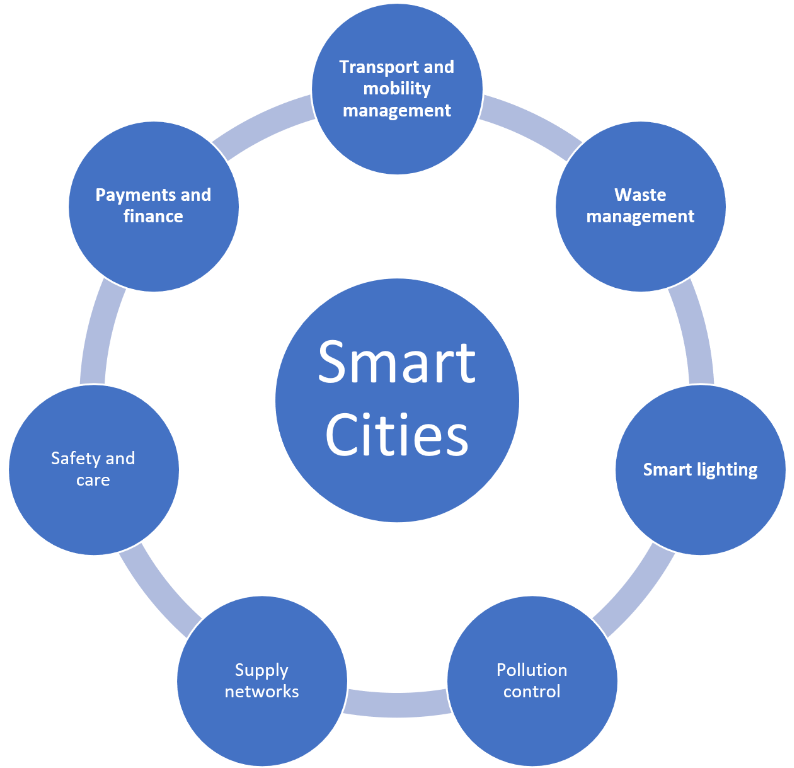Practical examples of Smart Cities solutions
A Smart City is a city in which new technologies are applied to optimize traditional services and offer new ones, improving the quality of life of citizens while promoting sustainability.
The deployment of a Smart City requires the cooperation of various stakeholders, such as citizens, communities, companies, and municipalities.
The main Smart Cities solutions can be classified into the following categories:
Transport and mobility management: For example, improving rush hour congestion by adapting traffic lights to the actual traffic density, directing a driver to the nearest on-street parking space, managing the use of shared vehicles (cars, bicycles, scooters...), or offering real time information on frequency of public transport. In particular, the company Nota AI (https://www.linkedin.com/company/notaai/) offers a solution aimed to smooth the circulation of emergency vehicles (ambulances, fire trucks, police cars...).
Waste management: Some of the solutions of this type are the detection of waste bin filling level to optimize the routes of the collection services, encourage recycling habits through crypto-rewards, or monitoring rodent bait stations to detect pests and infer possible poor waste disposal practices. For instance, the city of Madrid/Spain has installed trash bins capable of measuring and communicating the fill level, the temperature (to detect possible fires), and the availability of bags for pet excrement (https://diario.madrid.es/blog /2021/10/13/smart-bins-leading-technology-at-the-service-of-the-city/).
Smart lighting: Efforts in this category are focused on reducing energy consumption and optimizing the use and maintenance of infrastructures, for example, adapting the intensity of streetlights to the presence of pedestrians/vehicles, taking advantage of streetlights as %G radio nodes, or reporting failures in real time. For example, the company MESHLE (https://es.linkedin.com/company/meshle) offers a system that detects the presence and allows direct communication between nearby lampposts in a swarm-like mode, with the aim of illuminating the road ahead the vehicle and dimming the streetlights as the vehicle passes them.
Pollution control: For example, monitoring noise, air quality (levels of carbon dioxide/nitrous oxides/particles/pollen), or water quality (pH and nitrates), and sending notifications to the citizens. In particular, the company Kunak (https://es.linkedin.com/company/kunak) offers a complete solution for air quality control, from sensors to integration with Smart City frameworks.
Supply networks: This category includes solutions for optimizing electricity, gas, water, and communications supplies; the most popular example being remote metering management. However, there are many others, such as the successful crowdfunding campaign of AquaPing, an open hardware licensed device capable of using AI to identify broadband high frequency acoustics emitted by leaks in pipes, even those behind walls.
Safety and care: Some solutions in this category are crime prevention (such as the initiative launched in Durango,Spain to distribute buttons among women who can use them to send an alert to the police if they feel unsafe), detection and management of natural disasters (such as catastrophic flood sensors), health and care devices (such as fall detectors for elderly living alone), occupancy control using sensors that respect the right to privacy... A specific example is the Actibump solution of Edeva (https://es.linkedin.com/company/edeva), which is an automatic speed bump that is only activated if a vehicle approaches faster than the maximum authorized speed.
Payments and finance: Thanks to blockchain technology and the like, agile payment methods can be implemented, such as the one demonstrated by the car manufacturer Jaguar Land Rover and the IOTA cryptocurrency (https://www.linkedin.com/company/iotafoundation/), which allows drivers to sell information collected by their vehicles (such as road conditions, or air quality) and use the earnings to automatically pay for services such as parking.
As a Smart City is a system of systems, developing solutions for this sector requires understanding the operation of very diverse technologies and how each one contributes to the general architecture.
